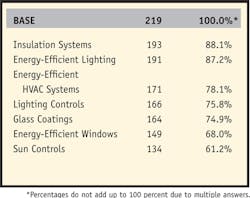Newsworthy: Readers’ Vision for the Future
In which areas will innovation make the greatest impact in architecture in the next 5 years?
(Please check only one.)
Which of the following products do you specify to increase energy efficiency? (Please check all that apply.)
What impact will kinetic architecture have on the field? (Please check only one.)
What "far-out" architectural technologies or technologies from other fields would you love to see available for architectural use? (an excerpt of answers)
- 3-D imaging
- aeronautical/aerospace technologies applied to building/structural design
- affordable, efficient, and practical alternative energy systems
- alternative energy sources for HVAC systems
- alternative framing and finishing materials
- better, more sophisticated solar and wind power generation
- biological panels (wall, monitors, cabinets)
- biomimicry
- Bluetooth technology
- buildings that are self-contained for power usage
- buildings that change shape for different functions
- carbon fiber structural elements
- ceramics
- chameleon building exteriors/interiors (they use technology to change color and appearance)
- clear plastic concrete
- co-generational systems
- composite structures such as composite graphite shaft technology from the golf industry and composite metals from NASA and aerospace
- computer-driven fabrication
- controlled transparency glazing
- convective loops
- cost-effective biometric security
- double-skin exterior walls
- embedded chip processors
- fiber-optic windows
- flexible LED membranes
- flywheel technology for storing electricity
- force fields
- fuel cells
- full automation
- full use of daisy chains and other methods of automation control as a standard along with backup of power, water, and other essentials
- geothermal and geo-passive energy generation
- heating and cooling of person via clothing instead of space
- holographic designs and design capabilities
- hot glass
- hydrogen fuel cell systems for buildings
- inflatable structures
- large-scale "Lego"-type blocks made of a sustainable material for the construction of small structures
- LED spotlights
- lightweight structures using bicycle frame technology
- living buildings
- organic skins that grow on walls
- "photo-grey" glass technology (eyeglasses) to adjust to daylight
- real-time 3-D
- renewable power sources
- responsive glazing
- robotic construction
- self-reliant mechanical/electrical systems
- suspended glass hardware
- the insertion of electrical signal wiring/lighting cabling into glass/glazing to control light levels achieved by illuminating windows/glazing
- translucent concrete to introduce daylight into spaces
- translucent solar collectors
- true systems integration
- vertical axis small wind turbines
- virtual reality
- wireless electricity transmission
